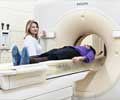Computed tomography (CT) scans are responsible for more than two thirds of the total radiation dose associated with medical imaging exams. However, a newly adapted low-dose technique called adaptive statistical iterative reconstruction (ASIR) may enable radiologists to reduce patient radiation resulting from CT up to 65 percent, according to a study published in the September issue of the American Journal of Roentgenology (AJR).
Iterative reconstruction is a technique that allows radiologists to reduce the noise in an image and improve image quality (like adjusting a TV antenna to make a "fuzzy" image sharper) while significantly reducing the radiation dose.CT scans using the newly adapted low-dose ASIR method and the standard dose method without ASIR were performed both on a phantom and 12 patients. "We found nearly identical image quality using the reduced dose CT method with ASIR compared with the standard dose CT method without ASIR," said Amy Hara, MD, lead author of the study, performed at the Mayo Clinic Arizona in Scottsdale. "In our study, patient radiation doses were reduced up to 65 percent using the low-dose IR method. The average radiation dose delivered during the low-dose CT with IR was 470 mGy; the average dose delivered using the standard dose CT without IR was 894 mGy," she said.
"Finding a way to reduce radiation dose for routine body CT imaging has been an ongoing concern for many. Our study is significant because it shows that the low-dose ASIR method can significantly decrease the radiation dose along with the many risks associated with radiation exposure. In future studies, it will be important to not only evaluate image quality but to assess diagnostic accuracy. ASIR is new to CT but in our practice it has been very successful," said Dr. Hara.
Source-Eurekalert
LIN












